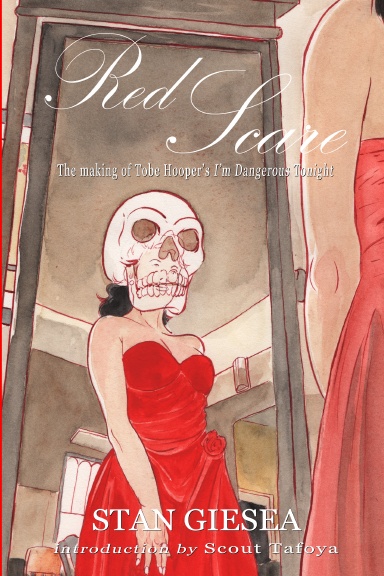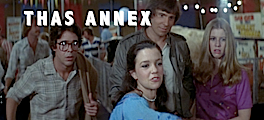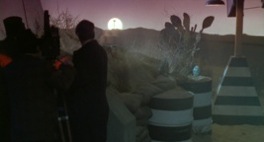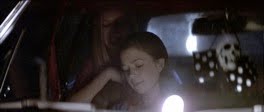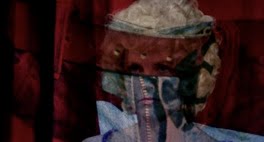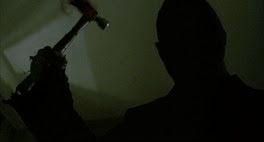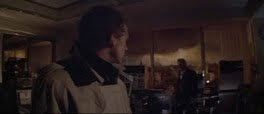Capsule reviews I've written in the meantime that span the entirety of 2022. Presented achronologically. Upped my game from 2021, so for that, I take some pride.
TAKEN
All ten episodes of the Spielberg Sci-Fi Channel miniseries. Surprisingly grotty: drug addiction, murder, Oedipal stuff, sexual grooming, and aliens. Hooper’s pilot naturally is the stuffiest and most fearful of transgressing into televisual goofiness, but that is the reason the other episodes have “Best of TV” life whereas Hooper’s only has his stock-in-trade formalist tropes that awkwardly impose movie-artificiality onto TV-artificiality. His “romantic horse-riding date” scene he rips off blatantly from Night Terrors and it's a pale imitation of cinema here. He’s obedient and afraid, but that doesn’t result in him betraying his sense of style, but misapplying it. Wish y’all could see his unaired Prey pilot, the more deranged misapplication of stuffy formalism to TV.
THE FUNHOUSE/EATEN ALIVE/THE TEXAS CHAIN SAW MASSACRE
A response to viewing a triple feature of all three in 35mm:
The trilogy of films of a sensitive soul. Hooper seems terrified of other people, encounters, and being faced with others who are not immediately simpatico (and there is never that in a Hooper film). He is the one truly entropic filmmaker, which is why his films have such lasting power. The Funhouse is less immediately impressive than Eaten Alive and The Texas Chain Saw Massacre (it's strange going from the proud vibrant experimentalism of those two films to what, to a full crowd, might collectively be seen as timid convention), the Texas Chain Saw redux elements I can do without, and its look at social ostracizing and inbred groups half-hearted at best (look to The Elephant Man for that), but it is certainly a film about subplots along a mutual track and the clearest evocation of his philosophy of telling multiple stories at once, stacked on top of each other.
It is really all about Amy, the survivor-by-chance, who connects with the recessive family (the monster and his family), her own, and her friends merely by chance. The details of the others' plots are incidental (Buzz, the oldest of the teens, works at a gas station; Richie considers college), though they are all connected by bad fathers. Hooper does not feel kindred to the two depraved boys - Joey and the "Anomaly" - though he attempts to give them an "out" through the fantasy of the film (in other words, these beings certainly cannot exist in real life; Carpenter's Halloween presents it as more of a given, while Zombie's revision corrects the original point). The Monster/Barker scenes are my least favorite, but it is all about how the scenes butt up against each other (after all, her friend is killed as Amy and Buzz... walk around? Not one moment is given over to expositional dialogue like "Where do you think she is?" or "We have to find her!"). It is also about Amy's almost imperceptible arc, which is her ability to dissociate until all her friends are dead and her relation to the monster is no longer just theoretical (though it has just occurred to me this describes most generic slashers, though they are never as aware; The Funhouse's real revolution is that Amy, its princess character, is just as ruthless as its cynics).
Its gestures are small and old-cinematic, like Hooper finally attempting that 50's Lean picture he had always wanted to make (he had "a romance with cinema [around the time he made The Funhouse]," he said once in an interview), but they, the film's incremental units of time, always have to do with the Moments missed and the weight of things falling like on you that is beyond your control. So, Funhouse’s plot describes the form of Brief Encounter - its narrative about lost moments, thus its form about it - which itself super-correlates to the narcotized form of Funhouse. In other words, this film does not attempt Cinema a la all its New and New-New Hollywood fetishists, but it carries the weight of a cinema (British golden age, perhaps neorealism) and all the gaps of story that signify a world crumbling and accelerating around you (Tourneur). Texas Chain Saw Massacre and Eaten Alive feel apocalyptic in their very form, but The Funhouse is the most apocalyptic of all of them because every second - i.e. every lost opportunity to be more cinematic, or even more thematic - is a grappling with our ability to disassociate from a life ticking by, crumbling from time, barely concealed by the story of a few bad fathers and dead kids.
THE NOVELIST'S FILM - #12 IN TOP FILMS OF 2022
Hong chases after a misshapen homunculus of equal parts novelist, filmmaker, and inhuman Superman without the flaws and short-sightedness of either the first two. Needless to say, neither the impossible homunculus or the Superman exist. Hong is not a novelist, he's a playwright at best, and it is never quite clear if he is trying to make this very point or the opposite - that his film's might as a well be plays (no. it would not alight, not spark). One watches this entire film that was built to chase its own tail and we come out the other end not knowing if Hong understands novelists at all, outside of the fact they suffer a different type of imposter syndrome than filmmakers do. At first it's about the novelist pursuing some sort of scopophilic liberty from the prison of words - which does suggest Hong knows the ease of film is, by that measurement, "preferable" to the cacophony of inner thought - this "evolves" to ending with a direct, almost resignatory Kiarostami cribbing that suggests one of the following: the novelist fails to find the synthesis of the art forms (at least what was in her head); the purity and immediacy of filmmaking; or the novelist achieving her escape from what is so stifling about the overweening empathy asked for by books, as she expresses earlier, and finding escape by becoming Hong himself... while bypassing all that is conventional, which is decidedly not how she expresses her ideas for the film earlier. She has in effect disavowed herself to become, metatextually, a male director (after previously telling off a Hong stand-in earlier in the film). Or, is it the things that escape us and are found in the process? Transfiguration? To suggest all of these things feels like cheating, and the undercutting of the others, while the path to apotheosis is redundant, and not in a fun way. That's not how Hong works, or it shouldn't be, as he writes things meticulously and is known for finding the harmony of things, even restlessness, and not for chasing aesthetic manifestos in 90 minutes. Best leave the chaos of emotions to Imamura and Kiyoshi Kurosawa. The Novelist's Film feels much too hardboiled for Schiller.
THE CATHEDRAL - #14 IN TOP FILMS OF 2022
Notes on an Appearance arthouse-indie wunderkind Ricky d'Ambrose skips making his crossover Jaws and skips straight to The Fabelmans. It feels a bit like a premature firing of a gun, and considering d'Ambrose attests to having a full-blown epic in script form reduce to its bare essentials in keeping with his instincts and first feature adds to this feeling like a film made as a prediction of a career and shrinking back from the challenge. Thankfully, this leap involves far less personal failings and ruing the day than Nate Parker's The Birth of a Nation.
PINOCCHIO
The indignities of puppets, even femme puppets/puppet people allies (Zemeckis' thing for female puppets is definitely his one alpha move over Spielberg). You know, sometimes films just do not work, and Zemeckis' deep level corporate CGI scientist (think John Amplas's military-commissioned scientist in Day of the Dead) output is surely disposable ephemera for dispassionate x-beta/y-omega/z-delta trials he is only interested in doing in a glazed-eye-on-the-prize way. Doesn't mean he is a bad filmmaker, though. He's still out there saving transhuman lives.
PLANET OF DINOSAURS
I loved this movie. It's on Amazon Prime. Please join me in the glow of experiencing such a discovery. Takes place on a deserted alien dinosaur planet but includes at least two refrains of my favorite standard "Auld Lang Syne," one where the crew sings it happily to a plaintive guitar instrumental (I reiterate, they're stranded on a desert planet without amenities) that turns into a minor key when they begin to further ponder their situation. Yes, it's badly made, but this is the Rio Bravo of badly made.
SCREAM
It’s the directors sink this. Sad thing, is I don’t know if Wes could’ve pulled off Gen-Z, gentrifying Woodsboro, without giving one of the teens eyeliner and some weird working-class shtick?
BENEDICTION - #1 IN TOP FILMS OF 2022
Deeply Beckettian irony underlies an "[It's all too much.] I can't go on. I'll go on" ethos of continuous self-flagellation for the absence of something one is always searching for. Very Freudian. Even the eros-driven roundelay of the middle section is just a diversion. Life is a condition of constant substitutions for a purity that may never have existed. Here, it is a cruciform for a "lost generation" of boys, a lost cause made painful because ghosts are as incommensurable a state of being as one being in utero - actually more so. Davies goes past nostalgia and enters a late-life consideration of the image that is death in relation to a homosociality that, so he (or his protagonist) sees, seems to deny the nostalgic present. Sassoon is a figure in history he abuses freely, contrary to the female protagonists of his previous two features.
CORNEILLE-BRECHT
A Jean-Claude Rousseau Production of a Jean-Marie Straub Film.
DEADLY FRIEND
I don't know anything about Craven's original conception of the film and how pieces were forced upon him, but the oddball teen world and violent, gnarly content seen together, this is just another one of his incoherent horror worlds, to me indistinguishable from the harsh retributory vision that informs 'Nightmare on Elm Street' and 'Deadly Blessing' (and am I to believe the final scare of Nightmare was also forced on Craven? Insane). Anyway, it's foolish to doubt the certified horror masters, Craven - the most recondite and retrograde of them - included. The existence of their visual point-of-view culled from traditional storytelling bedrock, but fueled by a searching curiosity, especially that of Craven's, is always clear, and no amount of bad decisions can sour that. The first half of this was invigorating world-building of an impossibly Minnellian teendom, the second half a poorer reflection of the first but with excellent, polished horror scenes (almost as if made by assignment?).
BRUISER
A profoundly apolitical work, in the best sense of the word. Just… don’t be a jerk. Preeminent director of chivalry in cinema - honor as charisma, charisma as honor - Raoul Walsh could’ve directed this tale 70 years ago and I would not bat an eye (barring the few period updates, like electronic money, sleaze culture, and punk music).
CODA
Why do I do this to myself, you ask? Because while I may have given up on civilization, I have not yet abandoned it. The whole film is like a cotillion scene in a John Ford movie. A rite of backwards passage film for us all to remember we all had our prom night. No wonder it shot straight to the Best Picture prize.
CLEOPATRA
The communists of classical Hollywood are at it again with this premake of Revenge of the Nerds, the titular nerds tasked to quantify and enumerate the eternality of love through their cynical march to progress. Cleopatra is an intellectual who sees past or at least through the tyranny of finite time and numbers (aka optics).
THE POWER OF THE DOG
Suffers from There Will Be Blood syndrome. Anderson’s confidence is overbearing as he meets his Greenwood score blow by bombastic blow, while Campion treats her score like a foreign intrusion. Nolan and Anderson get praised for their immersive quality - Campion deserves at least as much praise for not caring a bit how immersed you are. She still has a better grasp of the mystery of human sensory recall and all that it adds to storytelling, and that compensates even for how overtly artificial, clunky dramatically, and compulsively watchable this is in a Secret Garden, “Don’t even try starting a water cooler conversation about it (it's too unspeakable)” sort of way. May pair nicely with Drive My Car as (inadvertently) pop-culture-accepted works that nevertheless commendably follow the beat of their own private drum, being about the things that never can be expressed out loud or even at all.
COMRADE X
Chaos alternative to easy-going liberalist Ninotchka, King Vidor's intellectual curiosity as an artist of sociological metaphysics films stiffly a comedy without metaphysics, about characters without philosophy... only ideals (a poor substitute). "Americans aren't soulless," says Clark Gable, and Vidor's camera - perhaps indistinguishable from the usual visually-filtered American liberality we see in his other work, objectifying the wider world and finding only stark one-dimensionality - just stands by and gawks.
HER SOCIALIST SMILE
3 1/2 stars out of 5
I’m afraid my reserved rating will push Mr. Gianvito into the arms of HBO.
DANCE OF THE DEAD
The clearest articulation of Hooper's automaton thesis, on things neither living nor dead, alive but not autonomous; this is both about our changing intake of art and our changing values in general. Jerry D. Metz in his essay on Dance in the Hooper essay collection American Twilight mentions how Richard Matheson's original story was about refined suit-and-tie crowds taking in the cavorting cadavers, but now, it is angry, politically ambivalent punks with cattle prods. The loss of meaning in art and the spectacle, and remarkably finding beauty in that loss of meaning, that devolvement from refinement, which necessitates his (and our) adaptation. The beauty that is front and center here is not Hooper's directorial choices but in his presenting something at all in the current times of 2005 or 2055. Hooper assesses the state of the soul, as the diegetic titular act does with its ugly and meaningless "dance," given to an allegedly "devolved" audience. The beauty is in the "why," the searching of why things have gotten this way, no longer in art but in the absence of it. Nihilism as a necessity.
THE GIRL AND THE SPIDER - #6 IN TOP FILMS OF 2022
All the same tricks as The Strange Little Cat, it can be confused as the same film. But is it the disappointment in scale and vision it promises from that description? Nope. It is most assuredly an expansion on the first film’s family unit into a larger world of quirky Amelie-like communal life and breaching self-parody in its applying structuralist film pedantry onto wider living in general. It is Haneke 90210, Sirk 2.0 for social atomization. It is bigger in scope but no less fixated on inner lives. But like actual fellow structuralist Eugene Green, the Zurchers have mustered a sense of life and a pure playfulness that transcends arthouse appliqués and approaches a vivid-redundant view of the world. Ramon Zurcher himself asserts his control and discernment over his dollhouse narrative in adding Euro pop to the mix, to what was previously strictly classical in conception, in order to not keep their vision “simple” (read: “fussy”) despite it being unchanging.







